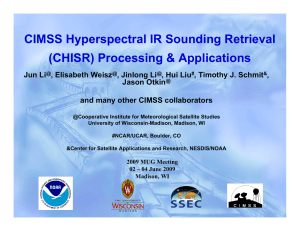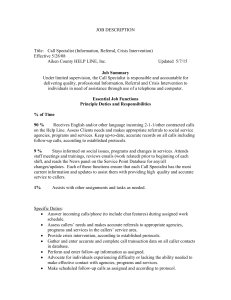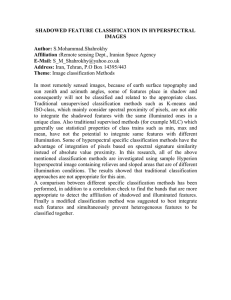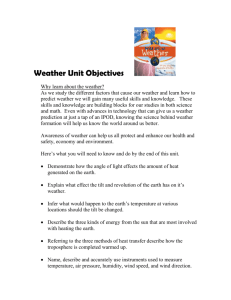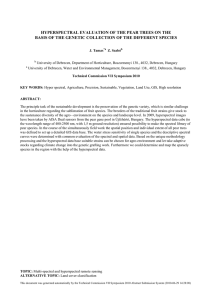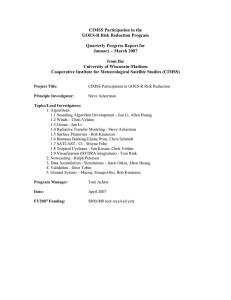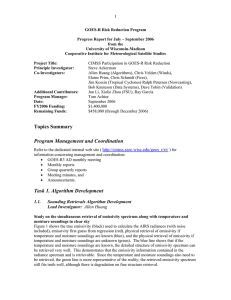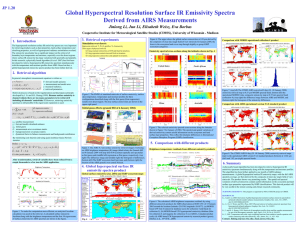CIMSS Hyperspectral IR Sounding Retrieval (CHISR) Processing & Applications
advertisement
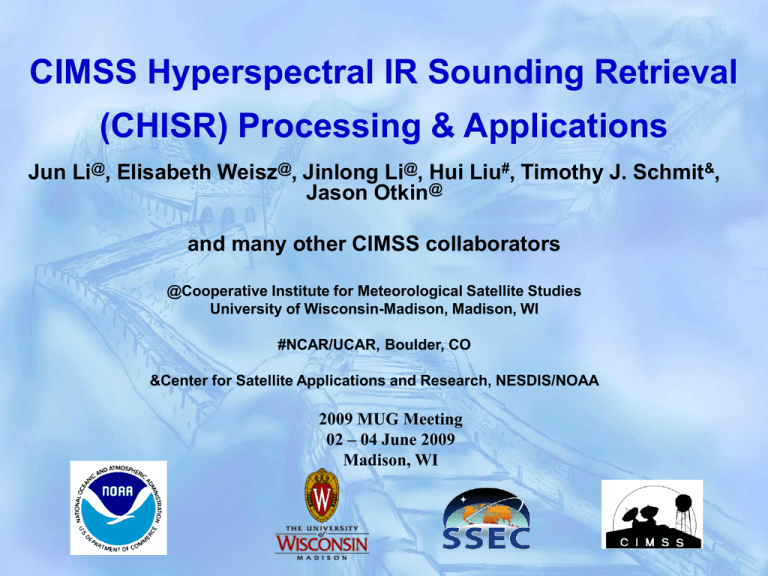
CIMSS Hyperspectral IR Sounding Retrieval (CHISR) Processing & Applications Jun Li@, Elisabeth Weisz@, Jinlong Li@, Hui Liu#, Timothy J. Schmit&, Jason Otkin@ and many other CIMSS collaborators @Cooperative Institute for Meteorological Satellite Studies University of Wisconsin-Madison, Madison, WI #NCAR/UCAR, Boulder, CO &Center for Satellite Applications and Research, NESDIS/NOAA 2009 MUG Meeting 02 – 04 June 2009 Madison, WI Outlines Introduction on hyperspectral IR sounder CIMSS Hyperspectral IR Sounding Retrieval (CHISR) Processing Hyperspectral IR sounding products and applications Summary and future perspective 2 Hyperspectral IR Sounder The Infrared Radiance Spectrum 3 Temperatur e weighting functions Moisture weighting functions Abundant Information Content allows the high vertical resolution temperature and moisture profiles with high accuracy ! 4 High Spectral Resolution - Global AIRS Data 20-July-2002 Ascending LW_Window 5 Brightness Temperature (K) Hyperspectral/Ultraspectral Infrared Measurement Characteristics - continue Texas Spikes down Cooling with height (No inversion) Spikes up Heating with height (low-level inversion) Ontario GOES GOES Wavenumber (cm-1) Detection of inversions is critical for severe weather forecasting. Combined with improved low-level moisture depiction, key ingredients for night-time severe storm development can be monitored. 6 Why sounding retrievals are needed? Easy to use Take advantage of full spectral coverage Less data volume 7 AIRS IASI CrIS The goal of CHISR is to provide a physically based optimal retrieval algorithm to simultaneously derive atmospheric temperature and moisture profiles, surface parameters and cloud parameters from hyperspectral IR measurements (e.g. from AIRS, IASI, CrIS) alone at single FOV resolution. CIMSS Hyperspectral IR Sounding Retrieval (CHISR) Processing Handle surface IR emissivity Handle clouds Retrieval algorithm 9 Handling surface IR emissivity Emissivity spectrum is expressed by its eigenvectors (derived from laboratory measurements) Regression retrieval are used as the first guess Simultaneous retrieval of emissivity spectrum and soundings in physical iterative approach (Li et al. 2007, 2008) 10 Re-group from IGBP category: Forests: Evergreen needle forests Evergreen broad forests; Deciduous needle forests; Deciduous broad forests; mixed forests; Shrubs: Opened shrubs; Closed shrubs; Savanna: Woody savanna; Savanna; Cropland: Cropland; Crop mosaic; Snow/Ice: Snow; Ice; Tundra; Desert: Desert/Barren; Global AIRS emissivity map – CIMSS research product (01 – 08 Jan 2004) Ecosystem land cover 11 Handling clouds Using collocated MODIS cloud mask for AIRS cloud detection (Li et al. 2004). Employ a cloudy radiative transfer model accounting for cloud absorption and scattering (Wei et al. 2004) Retrieval sounding and cloud parameters simultaneously (Zhou et al. 2007, Weisz et al. 2007) 12 AIRS BT spectrum Whole sounding in broken clouds and above-cloud sounding in thick 13 clouds can be derived First step: Regression CLEAR CLOUDY Training data set (SeeBor V5) Cloudy Training data set (ice, water) Radiance calculations Radiance calculations SARTA v1.7 (UMBC) Fast RT cloud model (Wei, Yang) Additional Predictors (spres, solzen) IMAPP RTV Software v1.3 BT and Scanang Classification Scanang Classification PC regression C dXAT (AAT )1 Ice Cloud Regr Coeffs Water Cloud Regr Coeffs Clear Regr Coeffs Regression RTV X X tr CAobs T, Q, O3, STemp, Emissivity at single FOV T, Q, O3, STemp, CTOP, COT at single FOV To physical inversion Second step: Physical Inversion Cost function for a quasi non-linear case: J (y F(x))T S1 (y F(x)) (x x a )Sa1(x x a ) Newton-Gauss Iteration with regularization parameter : x i1 x a (K iT S1K i Sa1 )1 K iT S1[y F(x i ) K i (x i x a )] x, xa K Sa, S F current /a priori atmospheric state vector Jacobian A priori / measurement covariance matrix Forward model Transform to EOF space: c i1 (K˜ iT S1K˜ i S˜ a1 )1 K˜ iT S1[y F(x i ) K˜ ic i ] c x˜ x˜ a x˜ x K˜ K S˜ a T Sa eigenvector matrix Second Step: Physical Inversion - flow chart Eigenvector matrix Matrices Sa and S Regression T,Q,O3,ctp,cot,de,emiss 1695 cm-1 Forward model calculations 1350 cm-1 1210 cm-1 water cloud, De=10,Cot=0.5 Jacobian calculations Q Jac COT Jac Next iteration dy y yc dyi dyi1 yes Decrease no (fail) Increase Physical Inversion Update Profiles # fails < f max # iterations < it max dy > dycrit yes no Physical RTV results T,Q,O3,ctp,cot,de,emiss Hyperspectral/Ultraspectral Infrared Sounding Performance in Clear Skies Hyperspectral Broad band Hyperspectral Broad band Can Achieve Improved Atmospheric Profile Accuracy 17 MODIS 1km images (1705, 1710) eye Hurricane Isabel case study environment AIRS data used for Hurricane IKE (2008) study September 6-7, 2008 (115oW – 30oW; 0 – 40oN) About 10 AIRS granules every day Single field-of-view (FOV) temperature and moisture profiles (13.5 km at nadir) from AIRS are derived using CHISR Clear sky only temperature and moisture soundings are provided in the assimilation experiment 19 Retrieved 500mb temperature (2008.09.06 – Used in assimilation) (K) (K) CIMSS/UW Clear sky AIRS SFOV temperature retrievals at 500 hPa on 06 September 2008, each pixel provides vertical temperature and moisture soundings. 20 Retrieved 500mb temperature (2008.09.07 - Used in assimilation) (K) (K) CIMSS/UW Clear sky AIRS SFOV temperature retrievals at 500 hPa on 07 September 2008, each pixel provides vertical temperature and moisture soundings. 21 Tracks of ensemble mean analysis on Hurricane IKE CTL run: Assimilate radiosonde, satellite cloud winds, aircraft data, and surface data. AIRS (Li and Liu 2009 - GRL) Analysis from 06 UTC 6 to 00UTC 8 September 2008 22 Track errors of on Hurricane IKE AIRS (Li and Hui 2009 - GRL) Analysis from 06 UTC 6 to 00UTC 8 September 2008 23 SLP Intensity on Hurricane IKE AIRS (Li and Liu 2009 – GRL) Analysis from 06 UTC 6 to 00UTC 8 September 2008 24 Assimilation Experiments (cont 1) 4-day ensemble forecasts (16 members) from the analyses on 00UTC 8 September 2008. Track trajectory and hurricane surface central pressure are compared (every 6-hourly in the plots). 25 Tracks of 96h forecasts on Hurricane IKE CTRL run: Assimilate radiosonde, satelliteAIRS cloud winds, aircraft data, and surface data. With AIRS No AIRS (Li and Liu 2009 – GRL) Forecasts start at 00 UTC 8 September 2008 26 Track errors of 96h forecasts No AIRS With AIRS (Li and Liu 2009 – GRL) Forecasts start at 00 UTC 8 September 2008 27 Typhoon Sinlaku (2008) 28 29 700 hPa water vapor mixing ratio (g/kg) (Sinlaku – 2008) Tracks of ensemble mean analysis on Sinlaku Analysis from 00 UTC 9 to 00UTC 10 September 2008 30 Tracks of 48h forecasts on Sinlaku CTRL run: Assimilate radiosonde, satellite cloud winds, aircraft data, and surface data. CTRL CIMSS Hui Liu (NCAR) and Jun Li (CIMSS) Forecasts start at 12 UTC 9 September 2008 31 Future Geostationary advanced IR sounder provides 4-D Temperature, Water Vapor, and Wind Profiling Potential GIFTS - IHOP simulation 1830z 12 June 02 GOES-8 winds 1655z 12 June 02 Simulated GIFTS winds (left) Vs. GOES current oper winds (right) 32 Summary CIMSS has developed an algorithm and processing package for full spatial resolution sounding retrieval from hyperspectral IR radiances in both clear and cloudy skies Hyperspectral IR sounder provides unprecedented global atmospheric temperature and moisture profiles that are critical for weather forecast and other applications Temperature and water vapor soundings from AIRS evidently improve ensemble forecast of hurricane track and intensity for Hurricane IKE and Typhoon Sinlaku (2008) Placing a hyperspectral IR sounder in geostationary orbit will provide four-dimensional fields of moisture, temperature and wind with high accuracy, which is critical for high impact weather nowcasting. 33
